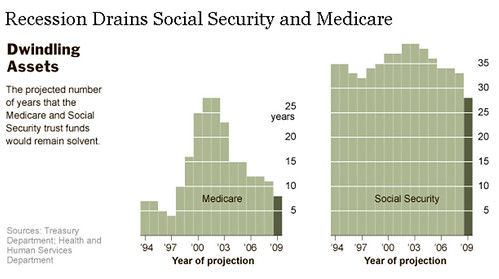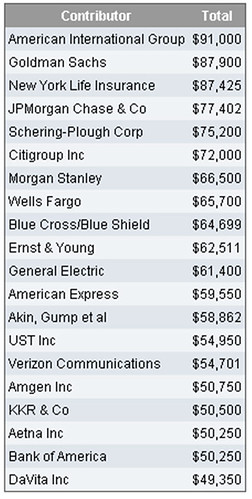 As you can clearly see the future of Medicare and Social Security is very bleak. The Treasury's 2009 projections indicate that Medicare only has only 1.5 little rectangles remaining, while SS has experienced a 20% year-over-year little rectangle reduction. Compounding matters, the little rectangles are turning black, which is a classic economic indicator of
As you can clearly see the future of Medicare and Social Security is very bleak. The Treasury's 2009 projections indicate that Medicare only has only 1.5 little rectangles remaining, while SS has experienced a 20% year-over-year little rectangle reduction. Compounding matters, the little rectangles are turning black, which is a classic economic indicator of The Treasury secretary, Timothy F. Geithner, said the only way to keep Medicare solvent was to “control runaway growth in both public and private health care expenditures.” And he said Mr. Obama intended to do that as part of his plan to guarantee access to health insurance for all Americans. But if cost controls do not produce the expected savings, Congress is likely to find it difficult to preserve benefits without increasing taxes.
Using  In reality, the health care and insurance industries are taking a page from the TARP playbook, where the specter of crisis.is being used to justify corrupt legislation. The health care lobby graciously agreed to reduce cost growth (not level, but rate of change) by 1.5%, yielding a projected savings of $2T over the next ten years. In exchange for this triviality, the insurance industry will receive a massive subsidy in the form of artificial demand creation; legally mandated health insurance for all US citizens in 2013.
In reality, the health care and insurance industries are taking a page from the TARP playbook, where the specter of crisis.is being used to justify corrupt legislation. The health care lobby graciously agreed to reduce cost growth (not level, but rate of change) by 1.5%, yielding a projected savings of $2T over the next ten years. In exchange for this triviality, the insurance industry will receive a massive subsidy in the form of artificial demand creation; legally mandated health insurance for all US citizens in 2013.This was the masterstroke of Senate Finance Committee's chairman, Max Baucus. Chairman Baucus spent long hours at the Roundtable to Discuss Reforming America’s Health Care Delivery System "hammering out" out the particulars with representatives from Blue Cross, Aetna, and the Business Roundtable. And when I say "hammering out," what I mean is selling legislation and the public interest for campaign contributions:
Lifetime contributions to Sen. Max Baucus via Opencecrets.org.




If we maintain these government-sponsored 'entitlements,' then it's destination Poor House.
ReplyDeleteAgreed, so long as nothing is done about the outrageous waste and expense that occurs in US medicine.
ReplyDeleteThe solution is no gov't support. People would have to make individual economic decisions on medical services to buy. And enterprises would be motivated to innovate in response to consumer-led buying dynamic. Entire system would change.
ReplyDeleteI've never been a fan of laissez-faire because I couldn't see how it wouldn't lead to the monopolization of industries with high barriers to entry. However, our current state of having the gov't owned by business, makes laissez-faire sound kind of nice.
ReplyDeleteA counter intuitive consequence of regulation is that it tends to RAISE barriers to entry and protect incumbents.
ReplyDeleteFor example, there's strong evidence to believe this drove the formation of the Federal Reserve a century ago. Big bankers saw their businesses being slowly wittled away by innovative entrants, and they saw regulation and oversight as a means to protect their franchises.
Monopolies rarely, if ever, persist in free markets due to 'creative destruction.' Persistent monopolies nearly always require government support.
My sense is that if more folks understood this linkage, then we'd be slower to regulate.